Day 1 of a three day Late Autumn / Early Winter Tour. It was a cloudy but dry start with some brief blustery showers developing through the afternoon, blown through on a brisk NE wind which became increasingly blustery through the day. We spent the day along the North Norfolk coast, heading east from Wells.
As we met in Wells, we headed straight down to Freeman Street car park first, where the Rough-legged Buzzard had been yesterday. As we got out of the minibus we could see it hunting over the bank at the back of the field, hovering. It was great to see it in action and we got a good look at its black belly patch contrasting with its pale head, and its white tail with a neat black terminal band. It landed in a bush on the bank, so we got the scope on it. Everyone had a good look, then it was off again, flying off strongly towards Holkham.
It was clearly a morning for raptors. Several Marsh Harriers were up now too, quartering the fields. A couple of Common Buzzards were perched in the trees beyond at first then flying around, with a Red Kite hanging in the air over the fields further back. A Sparrowhawk flew across low over the field in front of us, and later either the same or another Sparrowhawk flew off back the other way. There were a couple of Kestrels around too.
The Rough-legged Buzzard was still hunting, hovering in the distance. Then it flew back in towards us and landed in the rough grass at the back of the closest field. We could see its pale head and shoulders in the grass.
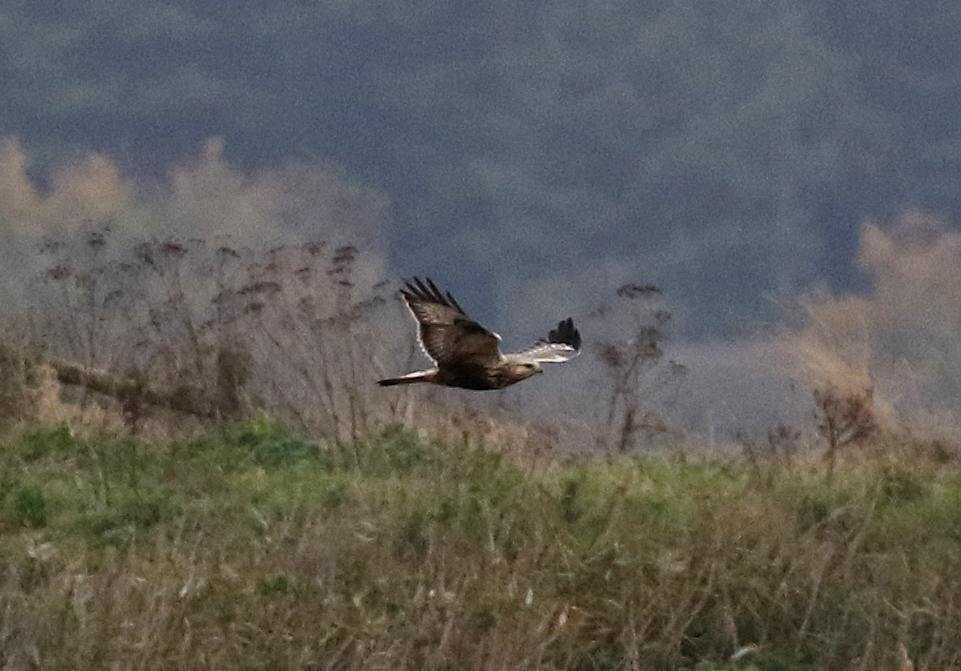
There were lots of other birds here too. A flock of Linnets whirled over the field periodically, and there were Goldfinches, Chaffinches and Greenfinches calling in the bushes behind us. Several Skylarks came up out of the game cover, and flew round. We could see some larger groups of Lapwings and Golden Plovers a couple of fields over, which periodically spooked and circled round. A large flock of Pink-footed Geese flew down towards Holkham.
Back in the minibus, we drove east to Blakeney. Lots of Pink-footed Geese were out on the grazing marshes further back and a small group of Greylags flew in to land on the grass in front of us – a good opportunity to look at the differences between them, the Greylags larger, paler and with a big orange carrot for a bill. A Little Grebe was hiding in one of the ditches.
We walked down past the duckpond, trying to avert our eyes from the gaudy collection of captive tame wildfowl on display! When we got up onto the seawall, it was much windier. Several Marsh Harriers were up here too, out over the Freshes, including two smart males, one of which was being hounded by a Rook. A couple of Grey Herons were in the grass with the cows, pretending to be Cattle Egrets. A sizeable flock of Brent Geese were out on the saltmarsh the other side, until they were flushed by a dogwalker.
Continuing on to the corner of the seawall, we stopped to scan the mud in the harbour. There were lots of waders here – a large group of Golden Plover, several small Dunlin feeding busily in front, and Grey Plovers too more scattered around over the mud. A single Bar-tailed Godwit was feeding in front of the vegetation at the back and there were several Curlews.
A Rock Pipit flew in and dropped down onto the saltmarsh. A large flock of Linnets whirled round periodically over the saltmarsh too, at one point flying in to the puddles on the grazing marsh behind us to bathe. We walked on a little further, and another smaller flock of nine finches flew past – Twite! We hoped they would drop in by the puddles too, but they continued on along bank and then turned out to the middle of the saltmarsh where they dropped down out of view.
A family of Brent Geese was feeding on a patch of more bare ground, two adults with two striped juveniles, plus a second pair with no young nearby. This smaller group was more settled and didn’t seem concerned by our presence close by on the bank. A Turnstone was picking around, appropriately enough turning over the small stones looking for food, just behind them.

It was very breezy out here, so we decided to walk back to try to get out of wind. Back on the corner, we stopped to scan the harbour again briefly. A couple of Red-breasted Mergansers and a Goldeneye came out of the harbour channel on the falling tide and flew out to the more open water. A Ringed Plover and several Oystercatchers on the banks of the channel were extra additions to the day’s wader list.
It was more sheltered in Friary Hills, and we had a quick walk round to see if there were any birds coming in. Several Blackbirds were in the thick hedge feeding on blackberries, possibly migrants, but there were no other recently arrived thrushes. We had a closer view of the Pink-footed Geese from here, dark headed, their small dark bills with a noticeable pink band. There were a few of the local Canada Geese mixed in with them.
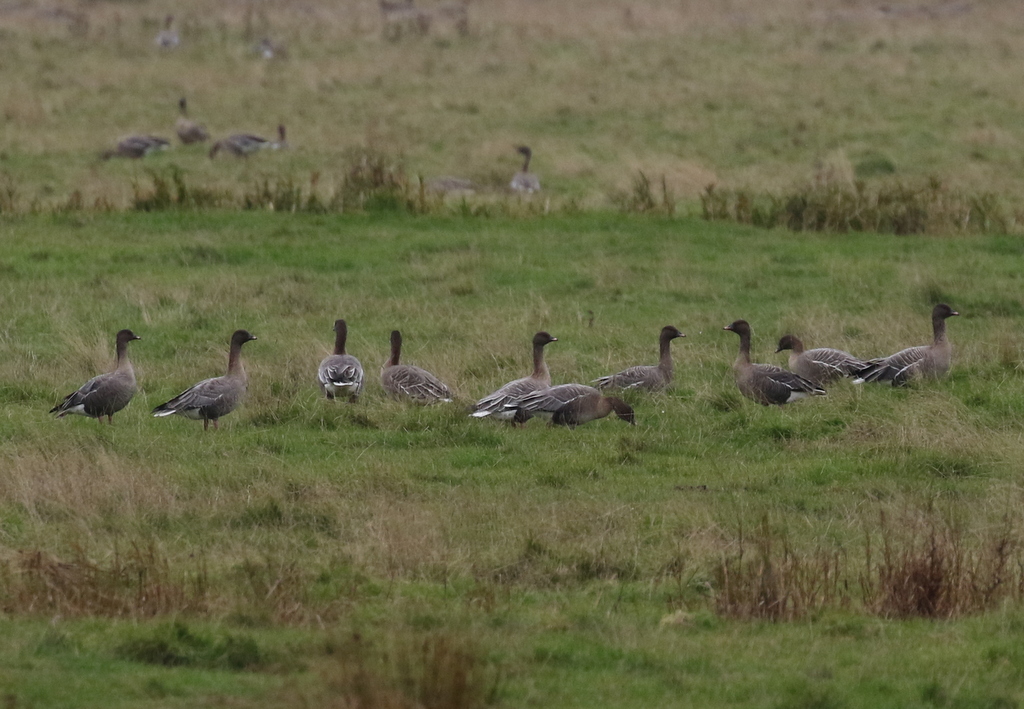
Some raptors were enjoying the wind, hanging over the edge of the trees at the top of the hill. There were two Common Buzzards, one a noticeably paler bird, rather creamy white below but lacking the black belly of the Rough-legged Buzzard we had been watching earlier. There was a Kestrel and another Sparrowhawk here too.
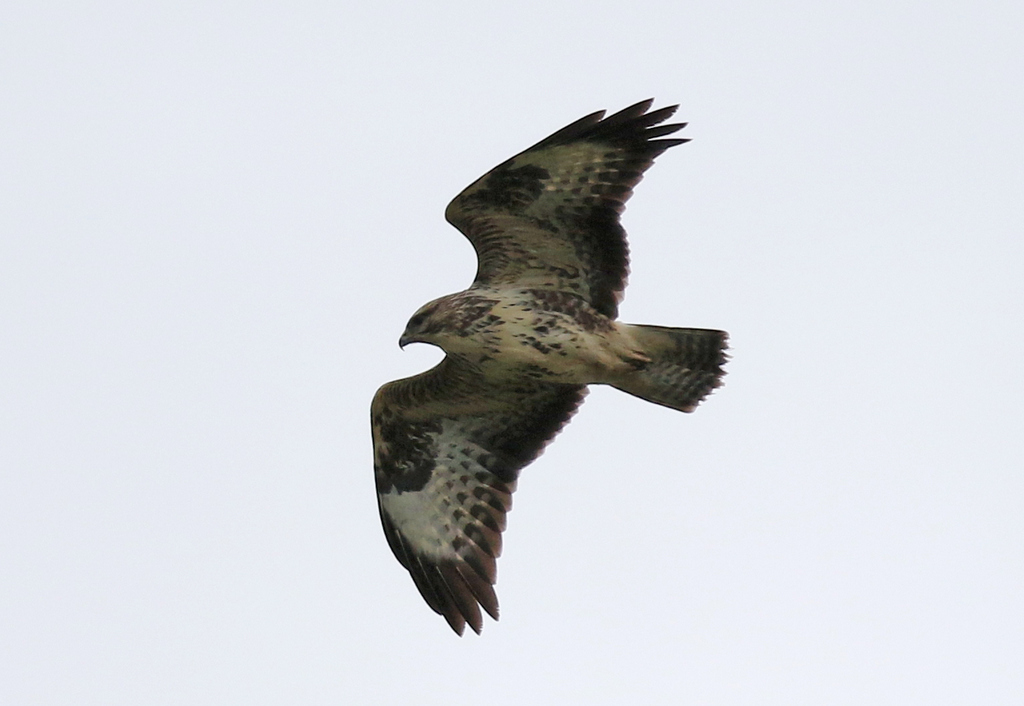
Following the path round up the hill, it was rather more exposed up at the top. A flock of Long-tailed Tits came out of gardens, and we could see a couple of them feeding in the thick blackthorn bushes. A Goldcrest was calling from the pine tree overhead but was hard to see in the wind. We made our way back down to the minibus.
Round at Cley beach, the shelter provided a welcome place out of the wind to have our lunch. Afterwards, we had a quick look out to sea. There had been a smattering of birds passing by offshore earlier, apparently, but there didn’t seem to be a lot moving now – we saw a single adult Gannet, which was the only thing of note. A Guillemot was on the sea, riding the waves.
An Isabelline Wheatear has been hanging around on the shingle ridge at the other end of Cley since last weekend, but there had been no sign of it this morning apparently, so we went round to the Visitor Centre for a hot drink and to make use of the facilities. We had just arrived in the car park when news came through that the wheatear had reappeared. So, after a short break, we headed out to look for it.
It was very blustery up on the East Bank. Four Gadwall were feeding on Don’s Pool and lots of Wigeon were out on the grazing marsh by the Serpentine. From out of the wind behind the East Bank shelter, we stopped to scan the brackish pools to the west. The resident Long-tailed Duck was busy diving over in the far corner, and we had a good look at it when it surfaced. There were a couple of Shelduck, a line of sleeping Shoveler and several Mute Swans on here too.
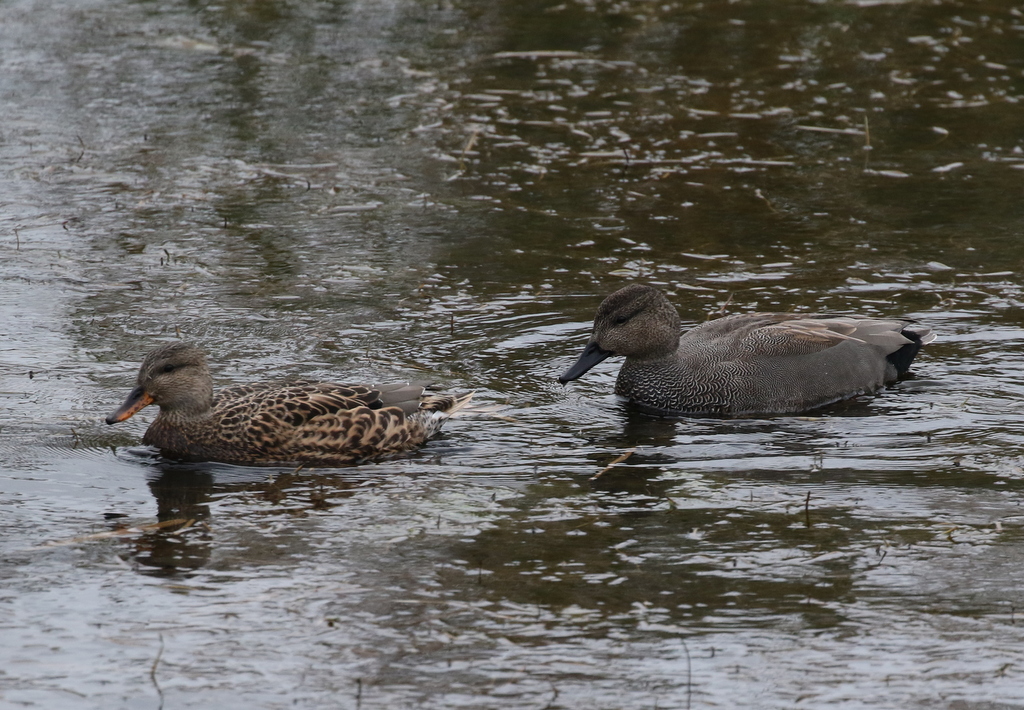
Braving the wind again, we walked on, out towards the beach. Looking up ahead of us, we could see a line of dark and white birds flying past just beyond the beach. They were about 25 Eider – a mixture of black and white drakes and dark brown females and young birds – coming in for the winter.
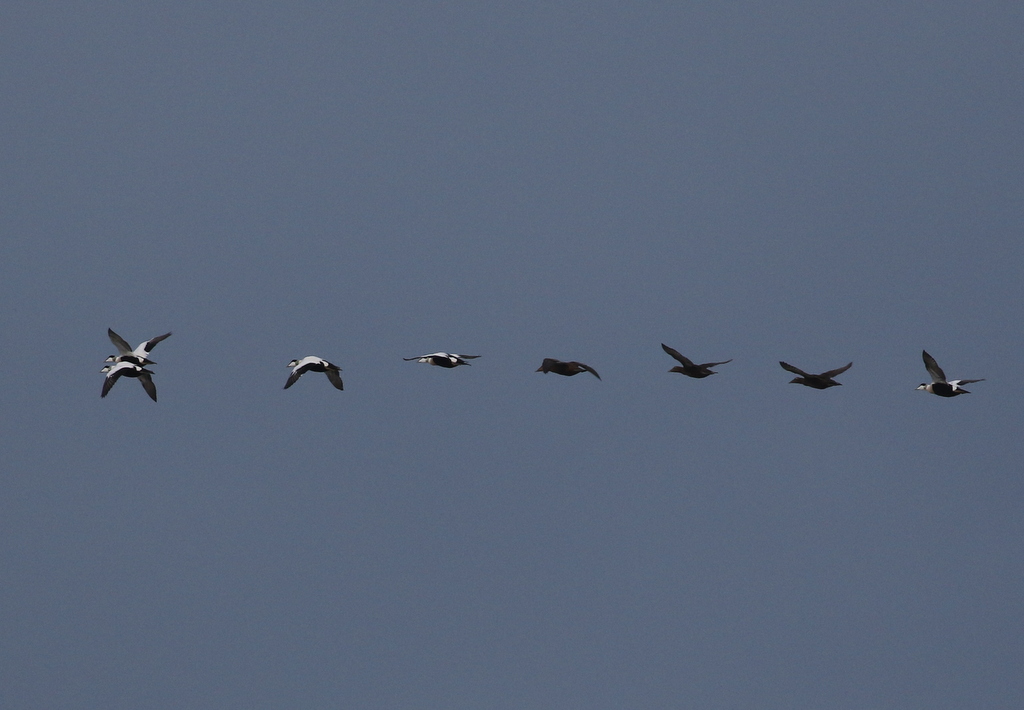
We turned onto the stones and walked east in the lee of the remains of the shingle ridge, behind the beach. We hadn’t gone far when we looked up as a large bird came in over the ridge and over our heads. It was a Short-eared Owl, presumably freshly arrived in off the sea from the continent. We watched it fly inland over Arnold’s Marsh, before we lost it to view from behind the low dunes beside us.
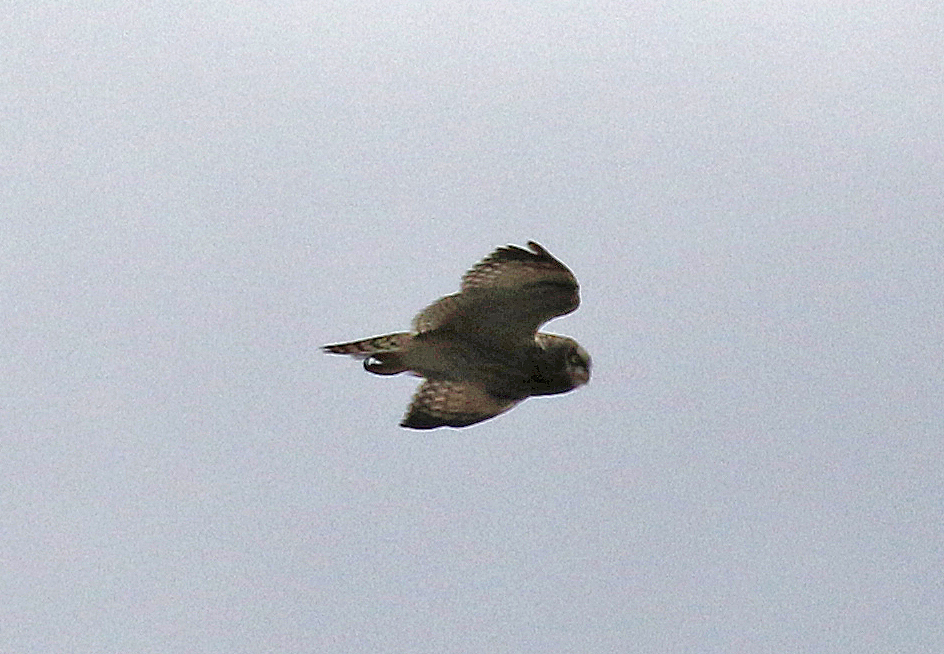
It was all action out here! A small crowd had gathered to see the Isabelline Wheatear a bit further along, so we walked up to join them. The wheatear was hiding in the long marram grass when we arrived, but after just a few seconds it came out. It showed very well, feeding on the short grass just beyond the fence.

Isabelline Wheatear is a very rare visitor to the UK. They breed in south-eastern Europe and migrate to Africa for the winter, so this poor individual had set off in the wrong direction and was now rather lost.
A single Snow Bunting was feeding on the weedy vegetation on the shingle ridge just beyond where we were watching the wheatear – apparently there had been a few more earlier, but they had flown out onto the beach. The Snow Bunting was very tame – coming here for the winter from their breeding grounds in Scandinavia or Iceland, there is every possibility it might not have seen people before.
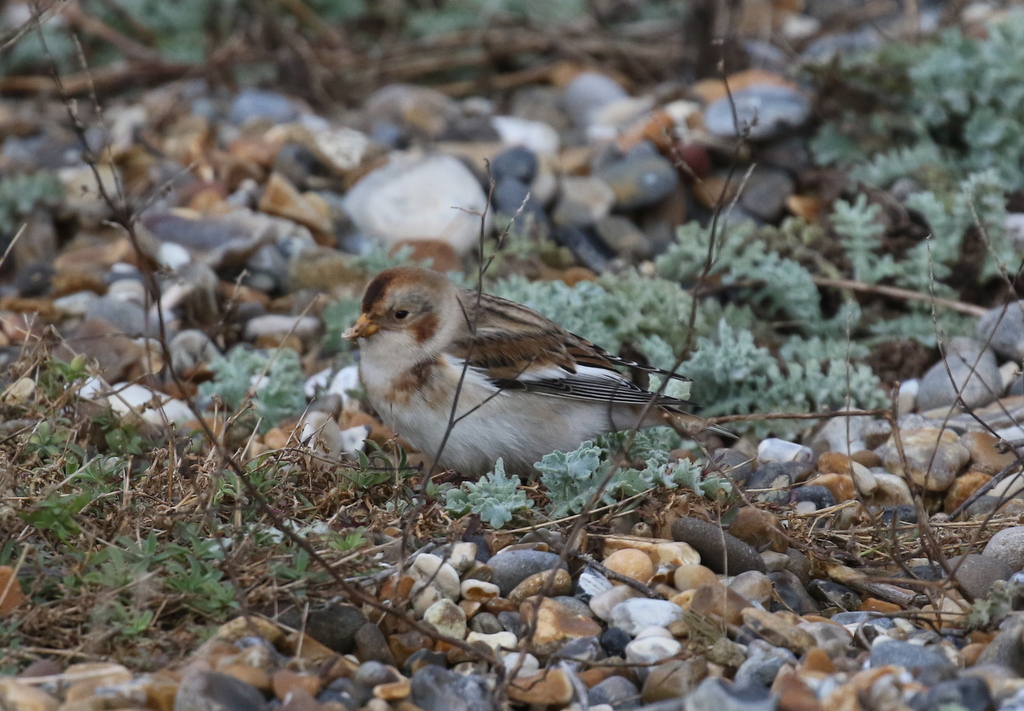
A squally shower blew in from the sea, so we stopped to wait for it to pass over, which it did thankfully quickly. Then we started to walk back. We climbed up onto the top of the shingle ridge on our way, to have another look at the sea. There were a few more Gannets flying past now and when we got back to the north end of the East Bank, we picked up a small flock of Kittiwakes offshore too.
We stopped for a quick scan of Arnold’s Marsh from behind the shelter. There were lots of Wigeon and Teal and several Curlews. Gulls were starting to gather but there was nothing different in with them. Out on Pope’s Pool beyond, we could see a large group of Cormorants drying their wings and several Great Black-backed Gulls.
The light was starting to go now, so we walked back to the minibus and called it a day. Despite the challenging weather at times, it had been a very productive day with some excellent birds. Hopefully with more to come tomorrow!
















